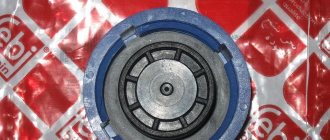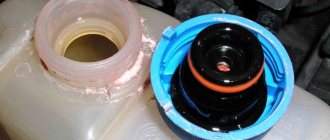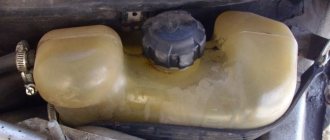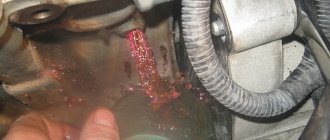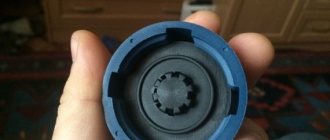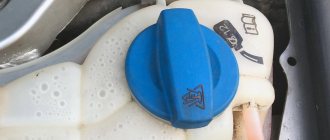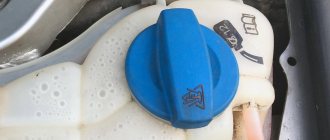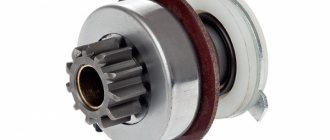Cars admin26.02.2020
Increased pressure or temperature in the cooling system and, as a result, knocks the antifreeze out of the expansion tank, and the car is covered in a cloud of steam. The situation is unfortunately familiar to many motorists. Regardless of the car brand, the principle of cooling the propulsion system is the same for everyone. Typical faults are also similar.
Antifreeze leaks from the expansion tank for many reasons, and most of them are directly related to the cooling system, but can also be caused by a violation of the vehicle’s operating conditions.
Malfunctions
The design of the expansion tank is simple. This is a plastic container in which a sensor is installed to detect changes in the nominal coolant level. The container is hermetically sealed with a lid with a pressure regulator valve, which is activated when the pressure in the system exceeds the standard value.
Depressurization
, caused by the tank, can only happen in two cases - either the material of the tank has cracked or the valve on the lid has failed and air begins to enter the system.
The problem can be much more serious if the breakdown occurred due to a burnt gasket
under the cylinder head (cylinder head). It is not always possible to determine such a malfunction by eye, because burnout could pierce the gasket both outside and inside the cylinder head. Here we recommend reading our article - “Symptoms of a blown cylinder head gasket.”
A breakdown of the thermostat also leads to a change in the physical state of the coolant, its temperature rises, and as a result, the pressure increases and knocks the coolant out through the check valve of the tank. To add to the problem, the antifreeze may also boil.
Replacing the BC gasket with your own hands
Replacing the cylinder block gasket is a simple manipulation, and any car owner can easily cope with this task on his own. The main condition for obtaining the desired result without additional breakdowns is to follow the car manufacturer’s recommendations regarding the strength and procedure for tightening the cylinder head with a torque wrench. The sequence of actions when replacing the gasket is as follows.
- The car is de-energized by removing the negative terminals of the battery. If necessary, drain the antifreeze and reduce the pressure in the supply.
- First, the attachments are disconnected from the cylinder block. If you have no experience working with parts, it is advisable to sketch or otherwise record the sequence of dismantling the elements. Craftsmen advise arming yourself with a marker and applying the appropriate marks to each dismantled part.
- The screws securing the cylinder head begin to unscrew from the center, making half a turn each time.
- Disconnect the cylinder head and remove the old gasket.
- Clean the cylinder head and wash it with gasoline.
- Install a new gasket. To ensure precise installation, there are special bushings on the center of the block. The hole for the oil passage should be between the 3rd and 4th cylinders.
- Screw all parts in reverse order.
- Return hanging elements to their place
We recommend: EGR in a diesel engine: what is it IMPORTANT! The fastening bolts must be cleaned before unscrewing. This will prevent the key from falling off and protect the bolt splines from damage.
Troubleshooting
Troubleshooting must begin with an analysis of the characteristics of its manifestation.
When idling
The coolant in the distribution tank behaves normally, but when the speed increases, it begins to rise and is knocked out, then we can speak with confidence about the following causes of failure:
- loss of tightness in the pressure relief valve;
- thermostat failure;
- pump breakdown;
- pipe rupture.
When the cylinder head gasket breaks, antifreeze will be knocked out even at idle, regardless of the engine operating mode.
The easiest way to determine
such a breakdown is to look at the smoke from the exhaust pipe. If smoke comes with white steam, you can be sure that antifreeze is leaking into the cylinder head.
If liquid drips from a pipe, then the most advanced motorists taste it. If the water tastes sweet, then it is antifreeze, if the water tastes bitter, it is antifreeze, the taste is neutral - ordinary condensation.
The reasons for the situation when antifreeze is knocked out of the expansion tank may be a breakdown of any unit involved in engine cooling
. If this is damage to the cover or the pressure relief valve built into it, then you can fix such a breakdown yourself by replacing the cover with a working one.
Replacing the thermostat and pump in a garage can also be done, but will require special knowledge and skills. But replacing the cylinder head gasket definitely needs to be entrusted to a specialist.
The coolant in the system of a VAZ-2114 car can not only properly perform its tasks, preventing the engine from overheating and heating the interior, but also create numerous problems. This is her nature.
Fix it yourself or go to a service station?
Once again I want to draw your attention, this is very important! All work on replacing cooling system elements is carried out exclusively with the engine turned off and the coolant cooled down.
You can replace the pipes, thermostat, radiator filler cap, and expansion tank cap yourself. Remove the filler cap on the radiator. Unscrew the drain plug on the engine and drain the coolant into a clean container.
As for replacing the gasket between the valve head and the piston block, repairing a rotten engine cooling jacket and repairing radiators, these works are best done at specialized stations. Since such repairs will require the use of specific tools and the necessary experience and knowledge.
Cooling tank design - looking for a leak on a VAZ-2114
We will not consider such situations when there is a crack in the tank the size of a finger, and antifreeze leaks out “brazenly.”
Everything is clear here; it would be strange if it didn’t flow out. Much more surprising are situations when liquid is squeezed out of the reservoir of an almost new car. Here it is worth remembering that the cooling system on the VAZ-2114, like other modern cars, is sealed , and it is designed in such a way that the liquid practically cannot boil.
Why does antifreeze squeeze out?
Clear signs of antifreeze leakage
At first glance, even a used tank looks very good. But this is only from the first. If an oil puddle regularly appears under the car after we have turned off the engine, the problem may be in the tank itself. The easiest way is to replace it with a new one, but the new one may not be of the highest quality.
Another problem that many have encountered is the quality of the lid and the simple valve that is built into it.
In this simple way you can check the expansion tank cap
Under normal conditions, the valve ensures complete sealing of the system, but if air does get in, there may not be many reasons:
- a crack on the tank body itself;
- depressurization of the system due to burnout of the head gasket, which can lead to rather dire consequences;
- unsatisfactory operation of the pump, due to which circulation in the system does not allow the liquid to cool normally;
- malfunction of the thermostat (see “replacing the thermostat”), in this case the antifreeze overheats because it simply does not enter the full circuit, but circulates in a small circle (useful material: installing a thermostat from Granta);
- microcracks on the cooling radiator (repair and replacement required);
- microcracks in hoses and pipes.
Disassembling and cleaning the expansion tank cap
Signs of an antifreeze leak
The most obvious signs of an antifreeze leak from the expansion tank are clear - a picturesque puddle appears under the car after a trip, and for the next trip it is necessary to top up the fluid again to the normal level. Nevertheless, antifreeze can escape through a leaky plug while driving, instantly evaporating, but there may be another reason with different symptoms:
- Antifreeze leakage through a broken head gasket . In this case, delay is death because once the fluid enters the lubrication system, it mixes with the oil in a matter of minutes. As a result, a gray emulsion is formed, which, naturally, is not capable of lubricating the engine. And this leads to jamming, overheating, and immediate wear of the crankshaft journals, camshaft, and cylinder-piston group. If the antifreeze has not yet managed to get into the lubrication system, but only into the combustion chamber, then the first sign of a leak will be abundant, thick white smoke from the exhaust pipe .
Leaks on the cylinder block from the timing side mean that the pump has failed (see “choosing a reliable pump for the VAZ-2114”)
Coolant circulation is disrupted
If circulation is disrupted, the fluid overheats greatly, pressure increases and the coolant is forced out through the valve cover. There are several reasons here.
- Thermostat malfunction. If the thermostat does not work, then the liquid will flow only in a small circle, bypassing the antifreeze cooling radiator. In this situation, the motor will overheat. It is necessary to check and, if necessary, change the unit;
- Air lock or clogged channels. Blockages appear due to scale, mechanical debris, improper mixing of antifreeze, etc. This is where the radiator is cleaned and flushed;
- Water pump failure.
conclusions
However, in any case, even if the cooling system tank is partially malfunctioning, it is better not to waste a couple of hundred and buy a new tank, having previously chosen a known quality one. Good roads to everyone and stable temperatures!
Sooner or later, owners of used cars have to deal with a malfunction such as a fluid leak from the engine cooling system. In order to detect such problems in time and successfully eliminate them, you need to understand why antifreeze is released through the expansion tank and for what reason its level constantly drops below the minimum. Sometimes this phenomenon indicates a critical malfunction of the power unit, so it is important to deal with the problem as soon as possible.
How does the expansion tank work?
The cooling system of a passenger car contains up to 10 liters of non-freezing liquid - antifreeze or antifreeze. During operation, it heats up in a very wide temperature range - from minus 30 °C (in northern regions) to +100 °C when it reaches operating mode. With such a delta, the liquid expands significantly, adding 5 to 10% in volume.
Hence the need for an additional reservoir that performs the following functions:
- Take away excess antifreeze resulting from heating.
- The cooling system of a car is closed and operates under pressure. When coolant enters the reservoir, the air layer is compressed and the pressure increases. To prevent it from squeezing out the plug, compressed air is released through the valve.
- During cooling, the reverse process occurs - the liquid leaves the reservoir, and the valve releases outside air so that vacuum does not occur in the pipes (an air lock may appear).
The expansion tank itself is a plastic container of any shape with a lid. The latter is equipped with a bypass valve, which releases/releases air or steam when the antifreeze boils.
Signs of cooling system problems
Symptoms of a malfunction include obvious and hidden antifreeze leaks:
- when the liquid is thrown out through the tank cap, streaks are visible around it and on the walls, and a wet spot appears under the car;
- leaks in other places - on pipes and connections, near the pump and the main radiator;
- hidden losses of antifreeze through a leaky cabin heater radiator or as a result of a burnt-out gasket under the cylinder head (cylinder head).
Obvious signs of leaks are easy to detect - by a puddle under the car and drips on hoses and assemblies. Moreover, the position of the wet spot on the asphalt does not always coincide with the location of the actual leak, since antifreeze flows to the ground through the elements protecting the crankcase and engine compartment from dust.
To detect hidden symptoms, a more in-depth diagnosis is needed, including disassembly. If the level in the expansion tank is constantly dropping and fluid has to be added, but the engine compartment is dry, the problem needs to be looked for in the cabin. You will have to remove the facing panels to get to the radiator and check its condition.
Note! When coolant splashes out of the heater radiator, it is absorbed by the floor covering, making the problem difficult to detect. An indirect sign is a sweetish smell of antifreeze in the cabin and a greasy deposit on the windshield in the form of fog, which is difficult to wipe off.
A burned-out cylinder head gasket is indicated by thick white smoke coming from the exhaust tract in any operating mode of the engine. Antifreeze penetrates the cylinders, evaporates when the fuel is burned, and is released through the exhaust pipe as steam. The second sign is the appearance of a suspicious dark-colored slurry in the expansion tank. This is an emulsion formed when antifreeze mixes with engine oil that gets into the cooling system.
Burst of hoses and damaged pipe is a problem that requires quick fix
What antifreeze to choose, choice by car make, orange antifreeze
For old cars with hundreds of thousands of miles on them, the problem of antifreeze leakage is most often worn out hoses. Over time, they lose their elasticity, crack and no longer withstand constant pressure. Its fastening at the junction also loses strength and weakens, which can lead to antifreeze leakage.
Advice! For preventive purposes, it makes sense to change the cooling system hoses after about 5 years of operation (for foreign cars - 10 years), and use screw clamps for fastening.
It is not difficult to find out that the hoses are the reason why the antifreeze quickly disappears. A careful inspection is enough. If obvious damage is clearly visible, then in order to identify small defects, you must first thoroughly rub all the hoses with a dry rag and run the engine at idle speed. After this, coolant leaks become clearly visible.
In some cases, it is necessary to carry out an operation to replace worn pipes. When performing this procedure yourself, you should follow certain recommendations:
- The car engine must cool completely;
- It is better to use a clean container to drain antifreeze, since it can be reused and can be poured back into the system;
- to make it easier to unscrew the clamps, you can lubricate them with a small amount of liquid oil or another product (for example, WD-40);
- after loosening the clamps, the pipe is carefully removed from the neck, remembering that almost all necks are quite fragile and easily damaged;
- Before putting on a new pipe, clamps are put on it;
- if difficulties arise when tightening a new pipe, you should not use any chemicals, it is only permissible to hold the pipe in hot water;
- The clamps are tightened tightly.



